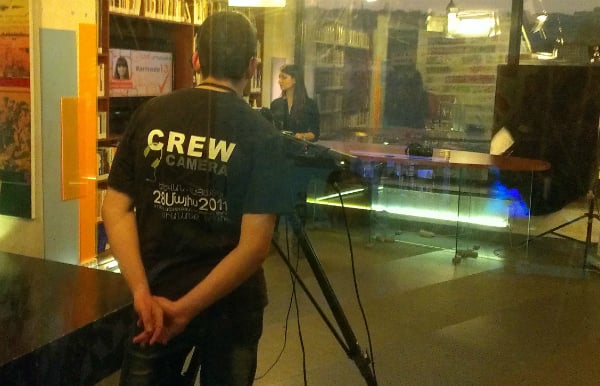
Since the 2013 presidential elections there has been a real competitive market in internet TV and online broadcasting in Armenia.
I’m not talking only about a growth in audience figures or in the number of viewers watching a live broadcast online. Websites offering online television supplement the often insufficient discussions and news analyses of broadcast television.
Prior to these elections, live online streaming in Armenia, first of all, was associated with rallies. The Armenian National Congress opposition bloc would hold another demonstration, and you didn’t have to go to Liberty Square or in front of the Matenadaran (the Institute of Ancient Manuscripts) but simply follow events online, in the comfort of your own home.
 Post-election developments in February 2013 provided more opportunities for broadcasting live online. Opposition leader Raffi Hovannisian’s rallies, his meeting and greeting people (which has led to the use of the term and hashtag #barevolution), the OSCE/ODIHR election observers’ press conference and the scandal surrounding it can now be viewed on several websites at once.
Post-election developments in February 2013 provided more opportunities for broadcasting live online. Opposition leader Raffi Hovannisian’s rallies, his meeting and greeting people (which has led to the use of the term and hashtag #barevolution), the OSCE/ODIHR election observers’ press conference and the scandal surrounding it can now be viewed on several websites at once.
Many have seen the scenes of Raffi Hovannisian, influenced by the wave of rallies in Armenia’s regions, tried to take CivilNet’s microphone and get on air live. CivilNet journalist Tatul Hakobyan intervened, saying, “Mr. Hovannisian, but you are interfering with out work.” Hovannisian then apologized and continued his barev* campaign.
This incident quite accurately reflects the situation at this stage of development of internet TV. Political and public actions are becoming more and more transparent. The entire post-election process, basically, is a complete reality show — broadcast online. The political figure, the police officer, and even the journalist himself is live online, which is a new situation for Armenia.
Added to this is also an element of quality. It’s not about broadcasting without commentary — online news reporters work on the spot, comment, and conduct live interviews.
 The rally is over? The press conference was scandalous? The chair of the National Assembly made a remarkable statement in parliament? There’s a student protest? The work of journalists back at the studio follows the live coverage and recorded subject (by providing context and additional commentary).
The rally is over? The press conference was scandalous? The chair of the National Assembly made a remarkable statement in parliament? There’s a student protest? The work of journalists back at the studio follows the live coverage and recorded subject (by providing context and additional commentary).
Journalists reporting live describe the details left out of the shot, and analysts or guests back at the studio round out the news with interesting discussions and debates. It is not only the broadcasting of the rally that brings visitors to a news website. 
Live broadcasting online is becoming more and more worthy of being called television.
And the audience is gradually corresponding to the audience of a small TV station.
In Armenia, there are three strong players in internet television: A1+, RFE/RL’s Armenian service (Azatutyun), and CivilNet TV. These three news outlets ensure online live broadcasts through the use of various technology and different platforms. Here are their post-election broadcast figures, which they kindly provided to us:
A1+ uses Livestream to broadcast its content. Audience figures on different days following the presidential election were as follows:
20 February 2013 10,642 visitors
22 February 2013 22,761 visitors
25 February 2013 7,240 visitors
Azatutyun TV uses its own system for online broadcasting and is unable to more accurately measure the effectiveness of its broadcasts, relying on Google Analytics instead:
21 February 2013 27,370 visitors
22 February 2013 47,005 visitors
23 February 2013 49,394 visitors
24 February 2013 59,065 visitors
25 February 2013 44,860 visitors
CivilNet TV uses Ustream. The following were the available figures for the post-election period:
Average number of daily visits: 33,000
Average number of the day’s busiest hours: 8,000
If we add the average figures of visits of these three main players, we find that 85,000–90,000 people are watching internet TV during this heated political period in Armenia.
Gegham Vardanyan
*Barev means hello in Armenian.
The views expressed in the column are those of the author's and do not necessarily reflect the views of Media.am.


Add new comment
Comments by Media.am readers become public after moderation. We urge our readers not to leave anonymous comments. It’s always nice to know with whom one is speaking.
We do not publish comments that contain profanities, non-normative lexicon, personal attacks or threats. We do not publish comments that spread hate.